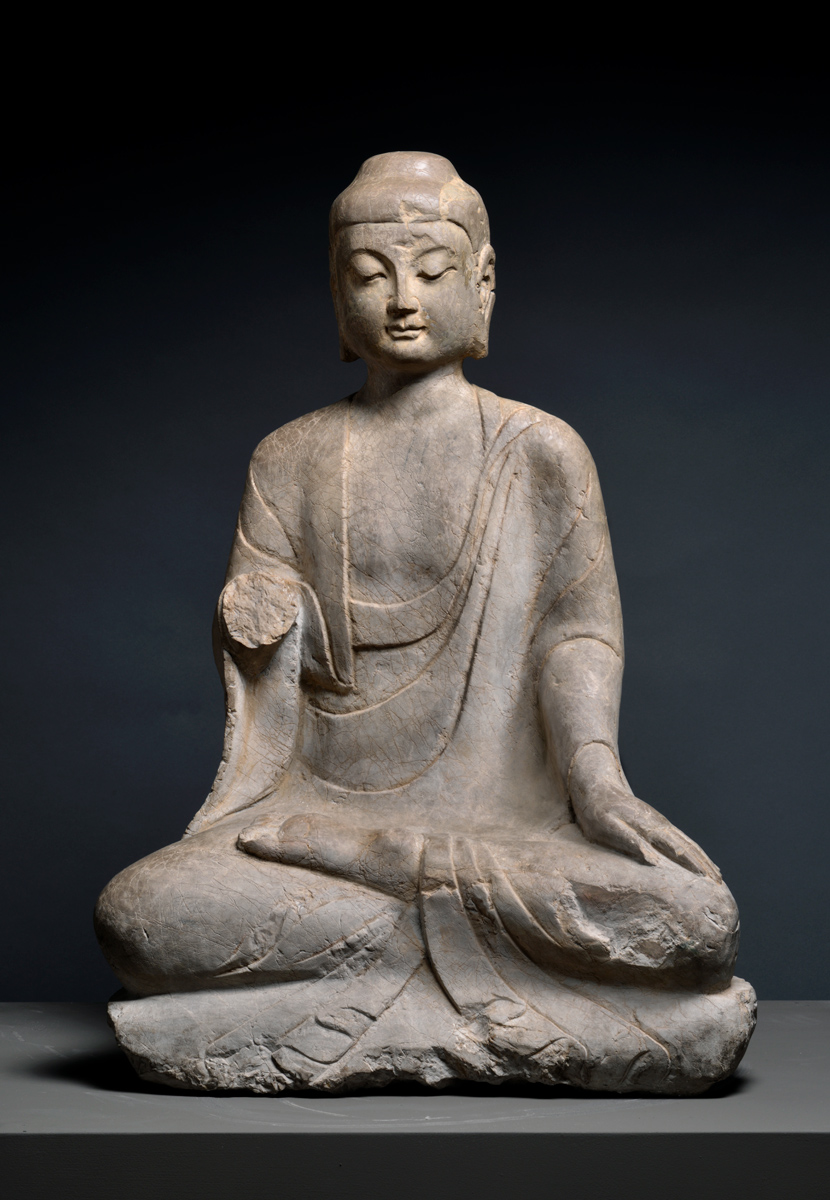
This exceptionally beautiful sculpture, depicting the historical Buddha, stems from the short-lived, but no less important Sui Dynasty (581-618 CE).
The sixth century was a very troubling and confusing period in China. The political and religious chaos culminated in the improbable speculations of emperor Wu of the Northern Zhou Dynasty, about strictly adhering to either Buddhism, Daoism or Confucianism. Finally, he turned against Buddhism, confiscating the monasteries and even persecuting Buddhist monks. After his death in 578, his successor, general Yang Jian (541-604) brought an end to the hostilities and, after three centuries of partition, unified the country again. He became known as Emperor Wen, founder of the Sui Dynasty. He regained the trust of advocates of the three philosophies and established his new capital in Chang’an. Aiming to restore Buddhism to its former glory, he built monasteries at the five sacred mountains, installed thousands of stupas and authorized the ordination of 230.000 monks and nuns. Buddhism became the basis for the ideological unification of his empire. In 604 his son succeeded him as emperor Yang, who initially continued the path of his father but eventually became the victim of his megalomaniac cravings for grandeur. His canal-building projects and failing military expeditions against Korea, turned out to be disastrous and created a revolt, which led to the fall of the Sui Dynasty in 618.
The present Buddha is a wonderful and convincing example of the rare qualities of late Sui sculpture. Managing somehow to fall discretely between the well-known styles of the preceding Northern Wei and the succeeding Tang dynasties, Sui works were relatively hard to either find or define.
In an essay, Marylin M. Rhie mentions the discovery of 2200 Buddhist sculptures in 1954, buried in the Hsiu-te ssu site in Ch’u-yang, west of central Hopei (North-East China): ‘Late Sui Buddhist Sculpture: A Chronology and Regional Analyses’ in Archives of Asian Art XXXV, 1982, published by the Asia Society. She states “…all are ranging in date from the Northern Wei to the mid-T’ang eras. In addition to several with inscribed dates important for a late Sui chronology, a number of excellent undated sculptures from the hoard can be stylistically ascribed to the second half of the Sui.”
It is a rare but fortunate coincidence that one of the sculptures she describes (fig.14, p.13 in the publication), even though its head is missing, stunningly resembles our sculpture. Quoting M. Rhie: “… (it) expresses in a most elegant way the same ethereal naturalism. Touches of naturalistic concepts may be seen in the soft tactile qualities of the fleshy parts, especially of the slender hand and foot, the subtly rounded limbs, and the graceful articulation of the left arm and hand. The garment folds are portrayed by delicate, shallowly carved lines in a variety of patterns: widely spaced folds crossing the chest and upper arms, disparate arcs over the legs, and wing-like clusters fanning out from the ankles.”
We can add to this, that the missing right hand would have shown most probably the abhaya mudra, taking away fear. Here, the existing head is imbued with a most serene facial expression with a distant smile. Buddha’s downcast eyes are defined by his over-arched brows that in turn initiate a fine, straight nose. The tiny mouth is embedded in the rounded volumes of the cheeks and chin. Long earlobes and a flat ushnisha on top of his smoothly stylized hair, articulate the symbols of his Buddhahood.
Looking at the back of the sculpture it becomes obvious that it was meant to be free-standing and to be seen from all angles. The back of Buddha’s robe is adorned with three U-shaped folds. It also reveals that the Buddha is seated on a lotus, which is hidden at the front side by the overhanging seat-cover and the cascading hems of his gown.
The refined, ethereal, almost fleeting representation of the Buddha, seems to have mastered the unforgiving conditions of cutting the extremely dense limestone into this rare, sculptured form. All this, too, from such a transient, though significant period, in Chinese history.
Provenance:
Collection Mr. and Mrs. L. Sanders, Antwerp, Belgium, 1997-2002.
Collection Mrs. B. Arango, Antwerp, Belgium, 2002-2019.
Report:
ASA, F. Maurer, Authentification et Datation d’Objects d’Art et d’Archeolie par Méthodes Scientifiques, Référence 10.12.12 – OA 3073, 30 Mai 2003, is consistent with the period of manufacture.
Literature:
Wai-Kam Ho, Notes on Chinese Sculpture from the Northern Ch’I to Sui in Archives of Asian Art, Duke University Press, XXII/1968/1969, figs.15,16,22,32,36.
R.Y. Lefebvre d’Argencé & D. Turner, Chinese, Korean and Japanese Sculpture in the Avery Brundage Collection, Asian Art Museum of San Francisco, Japan, 1974, fig.72.
M.M. Rhie, Late Sui Buddhist Sculpture: A Chronology and Regional Analysis in Archives of Asian Art, The Asia Society incl., XXXV/1982, p.44, figs.14, 19,21.
The Collection of Robert Hatfield Ellsworth, vol.1, Masterworks: Including Indian, Himalayan and Southeast Asian Works of Art, Chinese and Japanese Works of Art, Christie’s auction, New York, 17 March 2015, pp.84-87, lot.70.
Price On Request
|

